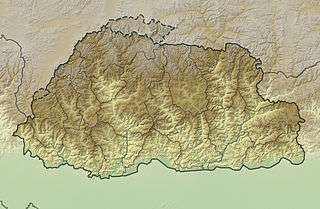Tala Hydroelectric Power Station
| Tala Dam | |
|---|---|
 Location of Tala Dam in Bhutan | |
| Official name | Tala Hydroelectric Power Station |
| Country | Bhutan |
| Location | Chukha District |
| Coordinates | 27°02′10.38″N 089°35′43.17″E / 27.0362167°N 89.5953250°ECoordinates: 27°02′10.38″N 089°35′43.17″E / 27.0362167°N 89.5953250°E |
| Purpose | Power |
| Status | Operational |
| Construction began | 1997 |
| Opening date | 2007 |
| Dam and spillways | |
| Type of dam | Gravity |
| Impounds | Wangchu River |
| Height | 92 m (302 ft) |
| Length | 128.7 m (422 ft) |
| Elevation at crest | 1,366 m (4,482 ft) |
| Dam volume | 3,520,000 m3 (4,600,000 cu yd) |
| Reservoir | |
| Total capacity | 9,800,000 m3 (7,900 acre·ft) |
| Active capacity | 3,200,000 m3 (2,594 acre·ft) |
| Catchment area | 4,028 km2 (1,555 sq mi) |
| Surface area | 360 m2 (0.089 acres; 0.036 ha) |
| Normal elevation | 1,363 m (4,472 ft) |
| Power station | |
| Commission date | 2006-2007 |
| Hydraulic head | 860 m (2,820 ft) |
| Turbines | 6 x 170 MW (230,000 hp) Pelton-type |
| Installed capacity | 1,020 MW (1,370,000 hp)[1] |
Tala Hydroelectric Power Station is a run-of-the-river type hydroelectric power station on the Wangchu River in Chukha District, Bhutan. The station consists of a 92-metre (302 ft) tall gravity dam which diverts water through a 22 km (14 mi) long headrace tunnel to the power station (26°50′26.36″N 089°35′12.55″E / 26.8406556°N 89.5868194°E) which contains six 170 MW Pelton turbine-generators. The difference in elevation between the dam and the power station affords the project a hydraulic head of 860 m (2,822 ft).[2]
Preliminary construction on the project began in 1997 and major works were underway by 1999. The first generator was commissioned on 31 July 2006 and the final on 30 March 2007.[3] The project cost was about US$900 million and was financed by India through grants and loan at a 9% interest rate. All of the electricity generated is exported to India through three 440kV transmission lines.[2]
The power station is the country's biggest hydropower project and the fourth after the Chuka project (336 MW) in 1988, followed by Kurichhu (60 MW) in 2001, and Basochho (40 MW) in 2005. Electricity revenue was expected to provide no less than 60% of the government's entire revenue in 2009. Yet, barely 66% of Bhutanese households and 39% of its villages are electrified.[4]
See also
References
- ↑ "Salient Features - Tala". DrukGreen. Retrieved 10 September 2013.
- 1 2 "Tala Hydroelectric Project, Bhutan". Power Technology. Retrieved 10 September 2013.
- ↑ "Tala Hydropower Plant". DrukGreen. Retrieved 10 September 2013.
- ↑ "Bhutan's happiness is large dam, fast GDP". The Economic Times, India. 2 November 2009. Retrieved 27 August 2014.